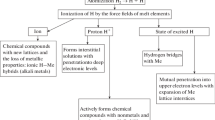Abstract
The trapping of hydrogen by various interfaces in iron and steels has been studied. The hydrogen content of pure iron specimens was found to depend more on hydrogen than those of low angle, and thus specimens with low angle grain boundaries were less susceptible to hydrogen damage. Inclusions and thermo-mechanical treatments were also significant in determining the hydrogen pick-up in iron. A critical volume fraction of inclusions was detected, below which no hydrogen- induced cracking occurred. Ferrite/pearlite and pearlite/pearlite colony interfaces in steel were found to trap hydrogen, whereas the ferrite/comentite interface within the pearlitic colonies had little effect on the hydrogen occlusivity.
Similar content being viewed by others
Author information
Authors and Affiliations
Additional information
Received: 26 May 1999 / Reviewed and accepted: 28 October 1999
Rights and permissions
About this article
Cite this article
Martínez-Madrid, M., Chan, S., Charles, J. et al. Effect of grain size and second phase particles on the hydrogen occlusivity of iron and steels. Mat Res Innovat 3, 263–270 (2000). https://doi.org/10.1007/s100190000043
Issue Date:
DOI: https://doi.org/10.1007/s100190000043




